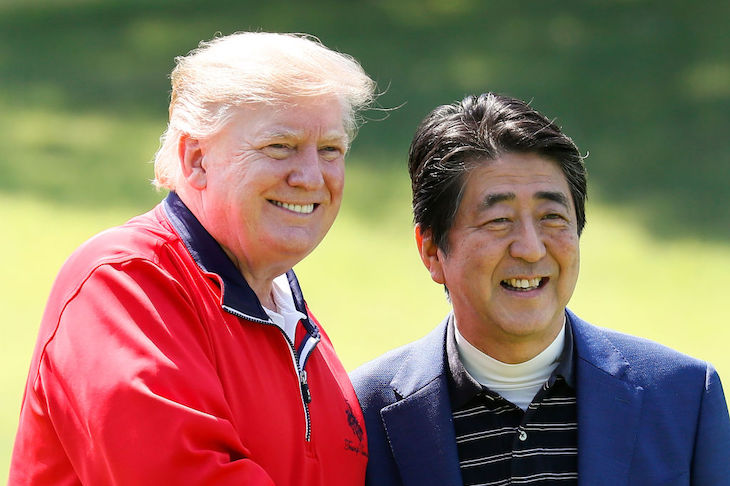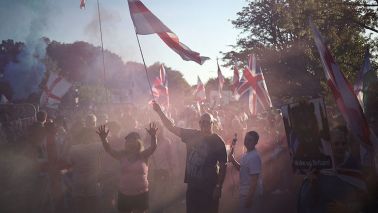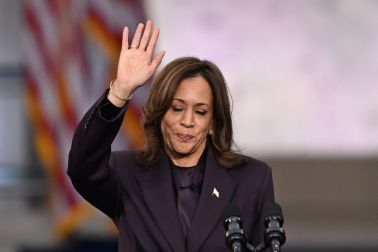Whenever I see pictures of Donald Trump and Shinzo Abe together I hear the theme music from the Neil Simon comedy The Odd Couple. For Trump and Abe are indeed the Felix and Oscar of global politics, a gently comic double act with starkly different but oddly complimentary personalities and all the appearance of a twilight years bromance.
The pair met soon after Trump’s inauguration when Abe rushed stateside to be the first foreign leader to pay his respects to the new president. Since then the relationship has blossomed, and they’ve met frequently, and conversed on some 40 separate occasions.
There have been some choice comic moments along the way. There was the Seinfeldian episode in July 2017 when Abe’s wife Akie apparently pretended she couldn’t speak English to avoid talking to the President, when seated beside him at a G20 banquet. Then there was Abe falling into a bunker during a round of golf on Trump’s last visit in 2018, and on the current tour both men struggled to lift enormous sumo trophies
Japan's PM Shinzo Abe falls into bunker during round of golf with @POTUS 🏌🏽 #golf897 pic.twitter.com/gQgNRBawHK
— みつや (@mitsuya_niwa) May 24, 2019
The purpose of Trump’s visit this time is not immediately apparent. Presumably talks on the serious issues of the day did take place, but they must have been smuggled in somewhere between a busy round of cultural activities and photo opportunities.
First off, of course, was golf, at the Mobara country club, followed by double cheeseburgers (really) for lunch during which the pair ‘deepened their friendship amid a cozy atmosphere’ according to the Foreign Office in Tokyo. It’s not known if Trump used his gold-plated golf putter gifted by Abe on a previous trip.
Next up was the sumo at Ryogoku where the Trump entourage commandeered 1,000 of the precious seats, turfing out the regulars in the process. Ancient traditions were summarily discarded to accommodate the President. Luxury throne like seats were provided to avoid the customary ring side crossed legs, and the traditional cushion throwing was banned lest the honoured guest get biffed on the head.
In the evening, with the wives in tow, there was a traditional Japanese robatayaki dinner of grilled fish and vegetables. This is a step up from their last date, when Trump got to choose, and opted for a cheeseburger and fries combo at Munch’s burger shack in Toranomon (the dish has since been renamed the Trumpburger, and you need to queue for hours to get one).
On Monday Trump was afforded the honour of being the first foreign leader to visit newly installed Emperor Naruhito, ‘a great honour and a great thing’, Trump said eloquently afterwards. And the whole shebang culminated with the two pals posing for more photos aboard the Kaga, Japan’s largest warship.
Scepticism is inevitably expressed about the Trump / Abe relationship, but those close to Abe have reported that the pair are genuinely fond of each other. And they do have much in common. Both were born into great wealth and have glided through life without much apparent effort, reaching their current elevated positions more by accident than design.
Neither man is noted for being particularly cerebral, and if you were being uncharitable you could say it’s a toss up over who speaks the better English. Both have a reputation for denouncing fake news, and both have had trouble with the mainstream media, with Abe accused of trying to ‘meddle’ in the reporting of state broadcaster NHK.
Both are old-fashioned conservatives with no time for modern ‘progressive’ politics. Trump’s ‘make America great again’ slogan is pretty similar to Abe’s ‘take back Japan’ line from 2012. Both have younger, rather high maintenance wives. There may be a bond between them with shared domestic discord: Akie Abe is known as the ‘domestic opposition party’ for her opposition to Shinzo Abe’s policies and her pro-LGBT views.
And for Trump, Japan is a relatively stress free travel destination, where he has been treated like a visiting monarch by an establishment with a marked preference for Republican presidents – a legacy of the never to be forgiven ‘Japan passing’ incident in 1998 when Bill Clinton spent 9 days in China and ignored Japan entirely. There have been no demos, grotesque inflatables, or paragliding gatecrashers – the Japanese are a hospitable and respectful people.
But despite the genuine warmth, tensions exist between the two leaders. Trump’s long-term aim is to recalibrate the trading relationship between the US and Japan to reduce the trade imbalance. Abe’s frantic love bombing – and he hasn’t denied the rumour he nominated Trump for the Nobel peace prize for his efforts with North Korea – is partly in the hope of forestalling potential tariffs until after the crucial lower house elections he faces in July.
And much of the positive imagery of this short tour, which at times looked like a falling in love montage from a romcom, is aimed squarely at the third member of the triangle: Kim Jong-un. The North Korean leader’s continued missile launches have caused grave concern in Japan, and threatened to drive a wedge between Japan and the US.
Trump’s response has been to proclaim the alliance with Japan ‘steadfast and ironclad’, a slogan with militaristic undertones that will have been noted in Pyongyang, but which has unfortunate echoes of ‘strong and stable’.
Let’s hope it doesn’t all end in tears.







Comments